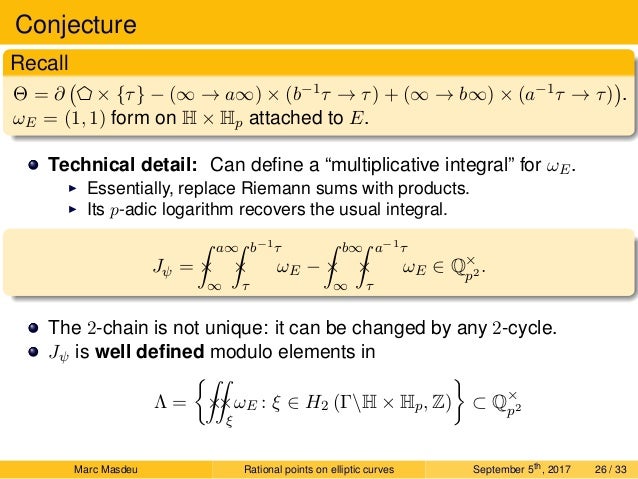Mathematics often poses intricate puzzles, and among its abundant mysteries, elliptic curves stand out as a particularly captivating subject. How can a seemingly abstract mathematical construct find application in the realm of cryptography? This inquiry opens up an intriguing pathway, leading us into the domain of rational points on elliptic curves, which serves as a playground for cryptographers seeking innovative ways to secure information.
At its essence, an elliptic curve is defined by a cubic equation in two variables with complex coefficients. These curves are not merely aesthetic; they possess intriguing algebraic properties that make them suitable for cryptographic applications. Specifically, the set of rational points on these curves provides a unique structure that lends itself well to the formation of cryptographic protocols.
In stark contrast to traditional number theory, the interaction between elliptic curves and their rational points invites exploration. To establish this connection, consider the Weierstrass form of an elliptic curve, usually expressed as follows:
y² = x³ + ax + b
Here, (a) and (b) are coefficients in the field of rational numbers, rendering the curve visually familiar yet algorithmically rich. The rational points on this curve consist of ordered pairs ((x, y)) that satisfy the equation with rational coordinates. These points, combined with the curve’s structure, form a group under a defined addition operation, creating a framework that is both dynamic and complex.
But what challenges lie within? How can the cryptographer exploit the properties of these curves? The answer begins with the group of rational points, which can exhibit exceptional properties based on the number of such points available. The challenge becomes evident: given an elliptic curve, determining the number of rational points is non-trivial. Notably, the underlying architecture of the Generalized Riemann Hypothesis suggests a profound connection with the distribution patterns of these points.
The profound implications of elliptic curves in cryptography are undeniably fascinating. One of the flagship protocols utilizing these properties is Elliptic Curve Cryptography (ECC). ECC leverages the complexity of the discrete logarithm problem on these curves. Unlike traditional systems such as RSA, ECC offers a more compact key size while ensuring the same level of security. This disparity is crucial, especially in an age where computational efficiency is paramount.
In cryptographic communications, employing ECC translates to creating public and private keys derived from the rational points of the elliptic curve. The hardness of the discrete logarithm problem ensures that, while generating a public key is straightforward, deciphering the corresponding private key remains a formidable task. This characteristic grants elliptic curves an essence of security, making them an attractive choice for secure communications.
The interplay of rational points with elliptic curves yields an expansive field of research. Delving deeper, one encounters the notion of torsion points—specific rational points with a unique role. Torsion points can be viewed as roots of unity on the elliptic curve, and they form a finite subgroup of the larger group of rational points. This provides a method by which cryptographers can construct secure digital signatures, authentication mechanisms, and more.
However, this playground is not without its hazards. Exploiting elliptic curves requires a robust understanding of several mathematical paradigms, including algebraic geometry and number theory. The risk of vulnerabilities looms, especially if improper parameters or curves with exploitable properties are employed. The infamous “small subgroup attacks” highlight the critical importance of selecting suitable elliptic curves that thwart potential attacks.
As cryptographers continue their exploration, a broader horizon of challenges emerges. The advent of quantum computing presents a new frontier that could potentially render many existing cryptographic systems obsolete. The search for new elliptic curves that resist quantum attacks has become an essential area of study, filling this cryptographic playground with novel challenges. The question shifts: How can elliptic curves adapt to the impending quantum era?
Through rigorous analysis and empirical observations, cryptographers strive to answer these questions. Techniques such as pairing-based cryptography harness the properties of elliptic curves to create new protocols resilient to various forms of attack. Incorporating advanced mathematical theories, these constructions push the boundaries of what is conceivable within the cryptographic landscape.
As we navigate this complex domain, the playful question remains: Can we forge new cryptographic solutions that remain impervious in a world increasingly reliant on digital communications? The intricate dance between elliptic curves and rational points continues, inviting mathematicians and cryptographers alike to a challenge rich with potential for revolutionary discoveries.
In conclusion, the study of elliptic curves and their rational points represents a frontier where mathematics meets practical application. The vibrant interplay of these concepts shapes the security protocols that underpin our digital world. As the challenges evolve, so do the strategies employed by cryptographers, ensuring that this playground remains both engaging and critical to the integrity of modern computation and communication.








Leave a Comment